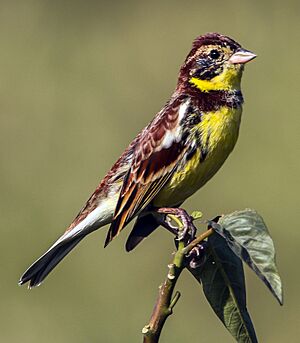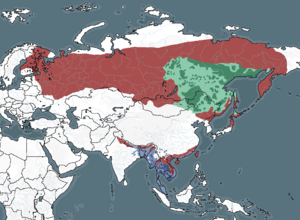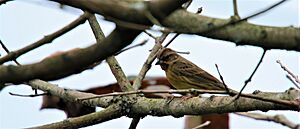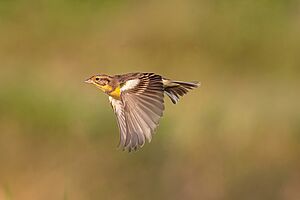Yellow-breasted bunting facts for kids
Quick facts for kids Yellow-breasted bunting |
|
|---|---|
 |
|
| Male in Nepal | |
| Conservation status | |
| Scientific classification | |
 |
|
| Breeding summer range overwintering Contracted range (extirpated) |
The yellow-breasted bunting (Emberiza aureola) is a small passerine bird. It belongs to the bunting family. You can find this bird across northern Europe, Asia, and eastern parts of the world.
The name Emberiza comes from an old German word for a bunting. The word aureola is Latin and means "golden." This refers to the bird's bright yellow chest. Its call sounds like a quick zick. Its song is a clear tru-tru, tri-tri.
Sadly, the yellow-breasted bunting is now a Critically Endangered species. This means it is at a very high risk of disappearing forever. Its numbers have dropped very quickly since 2004. Many of these birds are caught during their long migration, especially in China.
Contents
What Does It Look Like?
The yellow-breasted bunting is a small bird. It is about 14 to 16 centimeters (5.5 to 6.3 inches) long. It weighs between 17 and 26 grams (0.6 to 0.9 ounces). It is quite a strong and sturdy bird for a bunting.
Male and Female Birds
When breeding, the male bird is very colorful. It has a bright white belly with black stripes on its sides. Its upper body is brown. It has a black face and a black stripe on its throat. The lower part of its beak is pink.
The female bird looks a bit different. Her back is grey-brown with many streaks. Her belly is yellow, but not as bright as the male's. She has a whitish face with dark stripes on her head, around her eyes, and on her cheeks. Young birds look similar to the female. However, their belly and face are more of a pale yellow color.
Where Do They Live?
Yellow-breasted buntings live in different places depending on the time of year. One group, Emberiza aureola aureola, breeds in the northern forests from Finland to the Bering Sea. They then fly south to places like Indochina for winter.
Another group, Emberiza aureola ornata, breeds from the Amur River in Russia to Manchuria, North Korea, and the Kuril Islands. These birds are migratory. This means they travel long distances. They spend their winters in Southeast Asia, India, and North Korea. Sometimes, a few birds wander far from their usual path. They have been seen in western Europe, Alaska, and Canada.
In winter, these birds gather in large groups. They like to stay in farm areas, especially rice fields and grasslands. They often rest in rice fields at night.
Life Cycle and Breeding
Yellow-breasted buntings build their nests in open, bushy areas. They often choose places near water. They like dry rice fields for finding food and reedbeds for resting. They are common in Siberia during the breeding season.
The female bird lays four to six eggs in a nest built on the ground. When they are feeding their young, the birds mostly eat insects. At other times, they eat seeds.
Why Are They Endangered?
The number of yellow-breasted buntings has dropped very sharply since the early 2000s. This is why they are now considered critically endangered. The main reason for this decline is a lot of trapping. This trapping happens during their migration and in their winter homes.
Hunters use nets to catch the birds. They then sell them to be eaten. These birds are sometimes called "sparrows" or "rice birds." Even though this trapping used to be in a small area, it has become more common. As people have become wealthier, more hunters travel far to find enough birds. This has put a huge amount of pressure on the yellow-breasted bunting population.






